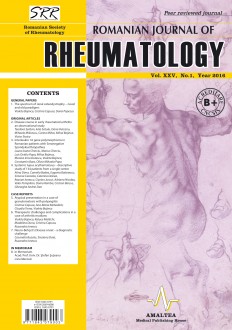SELECT ISSUE

Indexed

| |

|
|
|
| |
|
|
|

|
|
|
|
|
|
| |
|
|
HIGHLIGHTS
National Awards “Science and Research”
NEW! RJR has announced the annually National Award for "Science and Research" for the best scientific articles published throughout the year in the official journal.
Read the Recommendations for the Conduct, Reporting, Editing, and Publication of Scholarly work in Medical Journals.
The published medical research literature is a global public good. Medical journal editors have a social responsibility to promote global health by publishing, whenever possible, research that furthers health worldwide.
DISEASE COURSE IN EARLY RHEUMATOID ARTHRITIS: AN OBSERVATIONAL STUDY
Teodora Serban, Iulia Sătulu, Oana Vutcanu, Mihaela Milicescu, Carina Mihai, Mihai Bojinca and Victor Stoica
ABSTRACT
Background. In rheumatoid arthritis (RA), prompt diagnosis and initiation of disease-modifying treatment during the first months after disease onset - a period called “window of opportunity” – is significantly superior to the delayed start of the same therapy. Clinical remission is more frequently obtained in patients with a disease duration no longer than 4 months and is the main aim of the treatment, therefore the “treat to target” (T2T) and “tight control” strategies were proposed.
Objective. The aim of this study is to evaluate the therapy used for patients with early RA (ERA) and the impact of this medication on the clinical outcomes at 12 months after the first evaluation.
Methods. Patients with early arthritis who were referred to the Early Arthritis Research Center of “Dr. I. Cantacuzino” Hospital between 2010-2014 and who fulfilled the 2010 EULAR/ACR Classification Criteria for RA (and who did not satisfy classification criteria for other inflammatory rheumatologic diseases) were enrolled. Only patients who received treatment with Methotrexate (MTX) associated or not with corticosteroids (CS) and patients who fulfilled the classification criteria for RA but did not received any DMARDs therapy were enrolled.
Results. Forty-three patients were enrolled in the study, 62.8% females, mean age 55.47±13.71 years, median (interquartile range) DAS28 5.07 (4.31-5.60), SDAI 29.02 (20.92-34.61). At the first presentation, 40 patients (93.0%) received treatment with Methotrexate (MTX) in doses ranging from 5 mg/week to 20 mg/week, with a mean dose of 11.16±4.47 mg/week, the most frequently used doses ranging from 10 mg/week to 15 mg/week. 26 patients (60.5%) received corticosteroids (CS), either oral or intra-articular. During the study both the total number of patients receiving MTX and the mean dose of MTX increased, while the number of patients receiving CS decreased and at the end of the study only low-dose oral CS were still administered in 8 patients. At 12 months, median (interquartile range) DAS 28 was 1.77 (1.43-3.16), SDAI 3.58 (2.32-11.82). The evolution under treatment assessed by DAS28 and SDAI wasn’t significantly different between patients who received, at baseline, MTX in association with CS (mean value: ΔDAS28=-2.58±1.72, ΔSDAI=-20.44±16.49) and those who received MTX monotherapy (mean value: ΔDAS28=-2.91±1.17, ΔSDAI=-21.80±9.89) (p>0.05). There was no significant difference in change from baseline of DAS28 and SDAI at 12 months between patients who received low-dose oral CS and those who received intermittent intra-articular CS (p>0.05).
Conclusions. Treatment with MTX and/or CS led to clinical and laboratory improved outcomes at 12 months of follow-up. There was no significant difference regarding long-term outcomes between patients who received lowdose oral CS and those who received intra-articular CS. As this study was performed on a relatively small number of real-life patients with ERA, the results obtained should be validated on larger cohorts of patients.
Keywords: early rheumatoid arthritis, treatment, “treat to target”, clinical remission
